2004 FORD EXPLORER heating
[x] Cancel search: heatingPage 176 of 296
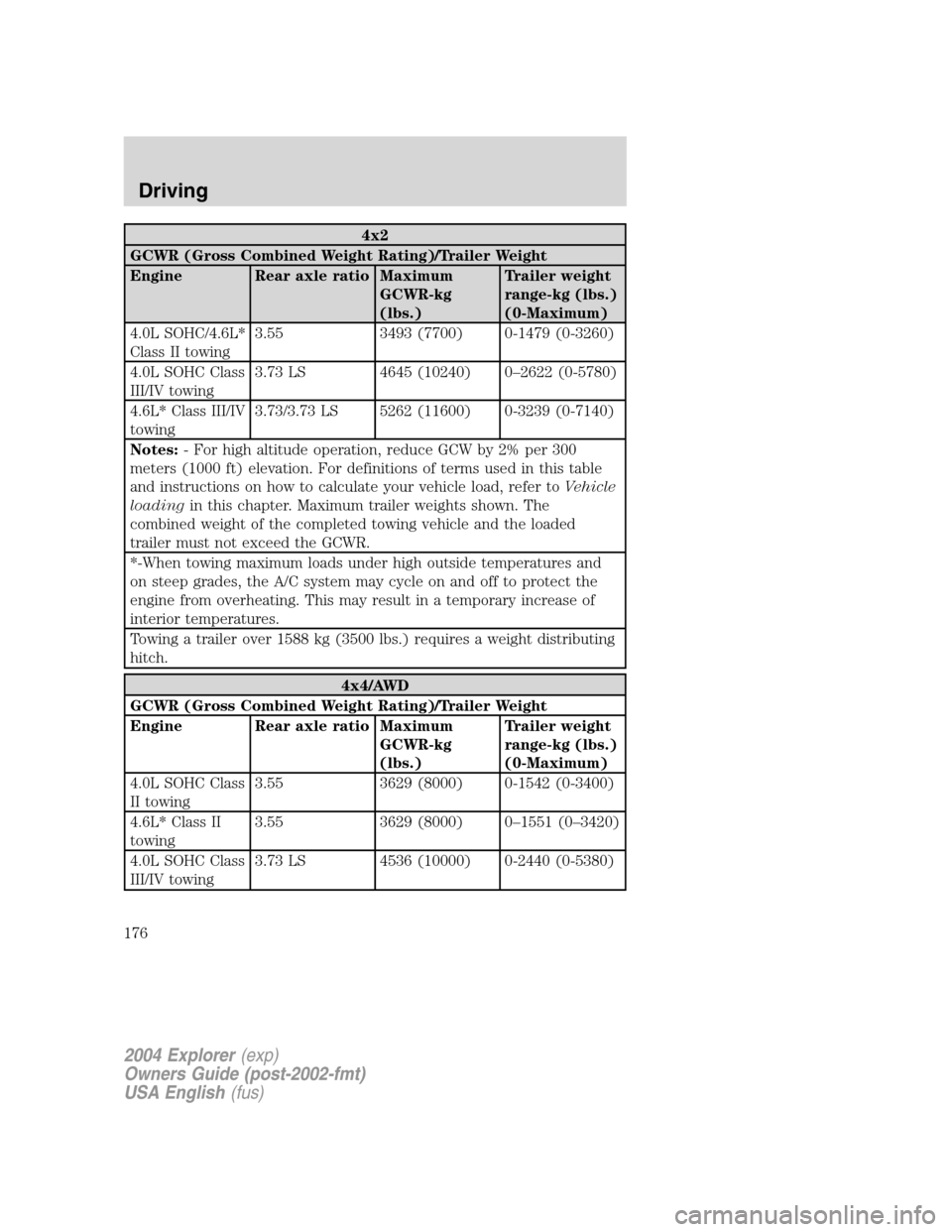
4x2
GCWR (Gross Combined Weight Rating)/Trailer Weight
Engine Rear axle ratio Maximum
GCWR-kg
(lbs.)Trailer weight
range-kg (lbs.)
(0-Maximum)
4.0L SOHC/4.6L*
Class II towing3.55 3493 (7700) 0-1479 (0-3260)
4.0L SOHC Class
III/IV towing3.73 LS 4645 (10240) 0–2622 (0-5780)
4.6L* Class III/IV
towing3.73/3.73 LS 5262 (11600) 0-3239 (0-7140)
Notes:- For high altitude operation, reduce GCW by 2% per 300
meters (1000 ft) elevation. For definitions of terms used in this table
and instructions on how to calculate your vehicle load, refer toVehicle
loadingin this chapter. Maximum trailer weights shown. The
combined weight of the completed towing vehicle and the loaded
trailer must not exceed the GCWR.
*-When towing maximum loads under high outside temperatures and
on steep grades, the A/C system may cycle on and off to protect the
engine from overheating. This may result in a temporary increase of
interior temperatures.
Towing a trailer over 1588 kg (3500 lbs.) requires a weight distributing
hitch.
4x4/AWD
GCWR (Gross Combined Weight Rating)/Trailer Weight
Engine Rear axle ratio Maximum
GCWR-kg
(lbs.)Trailer weight
range-kg (lbs.)
(0-Maximum)
4.0L SOHC Class
II towing3.55 3629 (8000) 0-1542 (0-3400)
4.6L* Class II
towing3.55 3629 (8000) 0–1551 (0–3420)
4.0L SOHC Class
III/IV towing3.73 LS 4536 (10000) 0-2440 (0-5380)
2004 Explorer(exp)
Owners Guide (post-2002-fmt)
USA English(fus)
Driving
176
Page 177 of 296
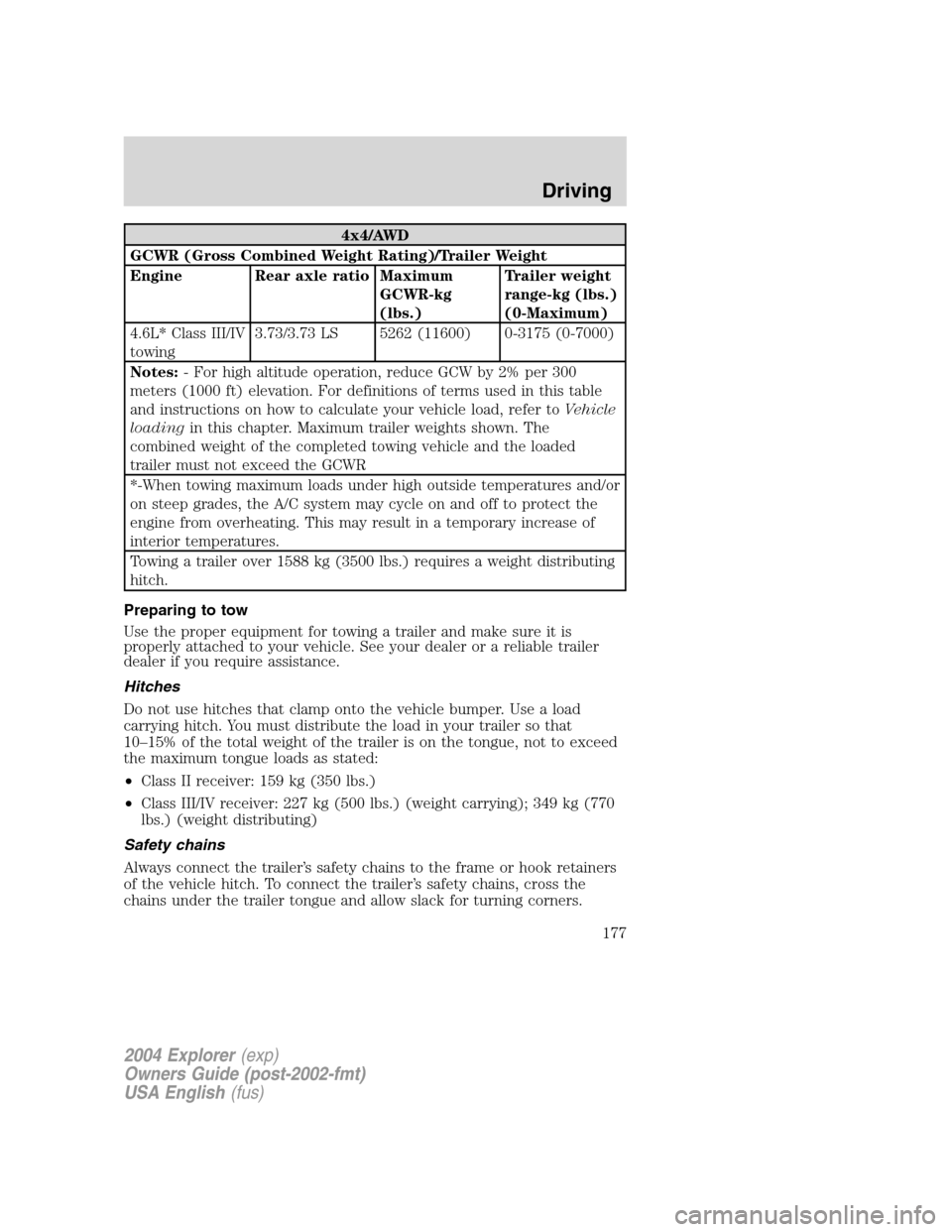
4x4/AWD
GCWR (Gross Combined Weight Rating)/Trailer Weight
Engine Rear axle ratio Maximum
GCWR-kg
(lbs.)Trailer weight
range-kg (lbs.)
(0-Maximum)
4.6L* Class III/IV
towing3.73/3.73 LS 5262 (11600) 0-3175 (0-7000)
Notes:- For high altitude operation, reduce GCW by 2% per 300
meters (1000 ft) elevation. For definitions of terms used in this table
and instructions on how to calculate your vehicle load, refer toVehicle
loadingin this chapter. Maximum trailer weights shown. The
combined weight of the completed towing vehicle and the loaded
trailer must not exceed the GCWR
*-When towing maximum loads under high outside temperatures and/or
on steep grades, the A/C system may cycle on and off to protect the
engine from overheating. This may result in a temporary increase of
interior temperatures.
Towing a trailer over 1588 kg (3500 lbs.) requires a weight distributing
hitch.
Preparing to tow
Use the proper equipment for towing a trailer and make sure it is
properly attached to your vehicle. See your dealer or a reliable trailer
dealer if you require assistance.
Hitches
Do not use hitches that clamp onto the vehicle bumper. Use a load
carrying hitch. You must distribute the load in your trailer so that
10–15% of the total weight of the trailer is on the tongue, not to exceed
the maximum tongue loads as stated:
•Class II receiver: 159 kg (350 lbs.)
•Class III/IV receiver: 227 kg (500 lbs.) (weight carrying); 349 kg (770
lbs.) (weight distributing)
Safety chains
Always connect the trailer’s safety chains to the frame or hook retainers
of the vehicle hitch. To connect the trailer’s safety chains, cross the
chains under the trailer tongue and allow slack for turning corners.
2004 Explorer(exp)
Owners Guide (post-2002-fmt)
USA English(fus)
Driving
177
Page 238 of 296
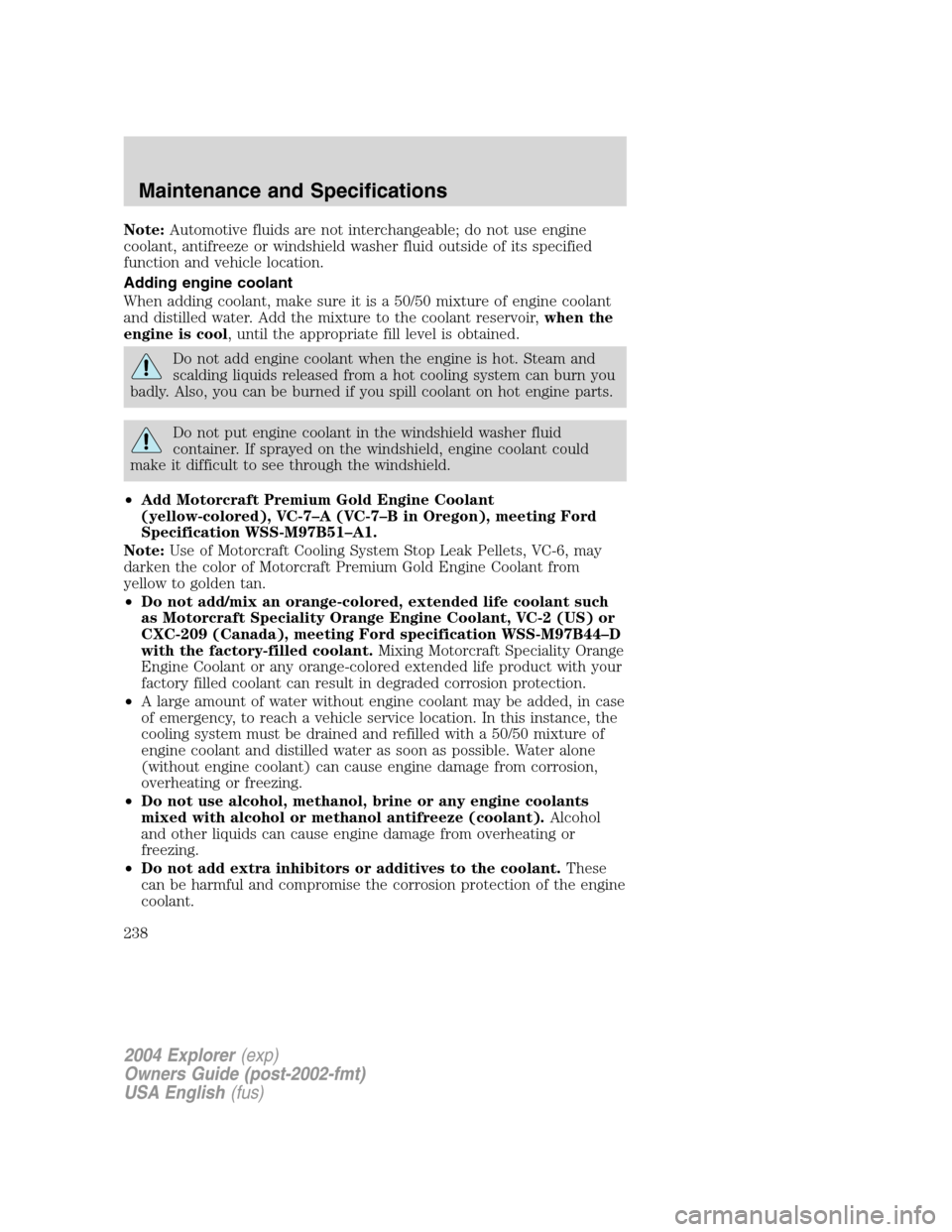
Note:Automotive fluids are not interchangeable; do not use engine
coolant, antifreeze or windshield washer fluid outside of its specified
function and vehicle location.
Adding engine coolant
When adding coolant, make sure it is a 50/50 mixture of engine coolant
and distilled water. Add the mixture to the coolant reservoir,when the
engine is cool, until the appropriate fill level is obtained.
Do not add engine coolant when the engine is hot. Steam and
scalding liquids released from a hot cooling system can burn you
badly. Also, you can be burned if you spill coolant on hot engine parts.
Do not put engine coolant in the windshield washer fluid
container. If sprayed on the windshield, engine coolant could
make it difficult to see through the windshield.
•Add Motorcraft Premium Gold Engine Coolant
(yellow-colored), VC-7–A (VC-7–B in Oregon), meeting Ford
Specification WSS-M97B51–A1.
Note:Use of Motorcraft Cooling System Stop Leak Pellets, VC-6, may
darken the color of Motorcraft Premium Gold Engine Coolant from
yellow to golden tan.
•Do not add/mix an orange-colored, extended life coolant such
as Motorcraft Speciality Orange Engine Coolant, VC-2 (US) or
CXC-209 (Canada), meeting Ford specification WSS-M97B44–D
with the factory-filled coolant.Mixing Motorcraft Speciality Orange
Engine Coolant or any orange-colored extended life product with your
factory filled coolant can result in degraded corrosion protection.
•A large amount of water without engine coolant may be added, in case
of emergency, to reach a vehicle service location. In this instance, the
cooling system must be drained and refilled with a 50/50 mixture of
engine coolant and distilled water as soon as possible. Water alone
(without engine coolant) can cause engine damage from corrosion,
overheating or freezing.
•Do not use alcohol, methanol, brine or any engine coolants
mixed with alcohol or methanol antifreeze (coolant).Alcohol
and other liquids can cause engine damage from overheating or
freezing.
•Do not add extra inhibitors or additives to the coolant.These
can be harmful and compromise the corrosion protection of the engine
coolant.
2004 Explorer(exp)
Owners Guide (post-2002-fmt)
USA English(fus)
Maintenance and Specifications
238
Page 239 of 296

For vehicles with overflow coolant systems with a non-pressurized cap
on the coolant recovery system, add coolant to the coolant recovery
reservoir when the engine is cool. Add the proper mixture of coolant and
water to the “cold full” level. For all other vehicles, which have a coolant
degas system with a pressurized cap, or if it is necessary to remove the
coolant pressure relief cap on the radiator of a vehicle with an overflow
system, follow these steps to add engine coolant.
To reduce the risk of personal injury, make sure the engine is
cool before unscrewing the coolant pressure relief cap. The
cooling system is under pressure; steam and hot liquid can come out
forcefully when the cap is loosened slightly.
1. Before you begin, turn the engine off and let it cool.
2. When the engine is cool, wrap a thick cloth around the coolant
pressure relief cap on the coolant reservoir (a translucent plastic bottle).
Slowly turn cap counterclockwise (left) until pressure begins to release.
3. Step back while the pressure releases.
4. When you are sure that all the pressure has been released, use the
cloth to turn it counterclockwise and remove the cap.
5. Fill the coolant reservoir slowly with the proper coolant mixture (see
above), to within the “cold fill range” or the “cold full” level on the
reservoir. If you removed the radiator cap in an overflow system, fill the
radiator until the coolant is visible and radiator is almost full.
6. Replace the cap. Turn until tightly installed (until “clicks” are heard).
(Cap must be tightly installed to prevent coolant loss.)
After any coolant has been added, check the coolant concentration, refer
toChecking Engine Coolantsection. If the concentration is not 50/50
(protection to –34° F/–36° C), drain some coolant and adjust the
concentration. It may take several drains and additions to obtain a 50/50
coolant concentration.
Whenever coolant has been added, the coolant level in the coolant
reservoir should be checked the next few times you drive the vehicle. If
necessary, add enough 50/50 concentration of engine coolant and
distilled water to bring the liquid level to the proper level.
If you have to add more than 1.0 liter (1.0 quart) of engine coolant per
month, have your dealer check the engine cooling system. Your cooling
system may have a leak. Operating an engine with a low level of coolant
can result in engine overheating and possible engine damage.
2004 Explorer(exp)
Owners Guide (post-2002-fmt)
USA English(fus)
Maintenance and Specifications
239
Page 286 of 296
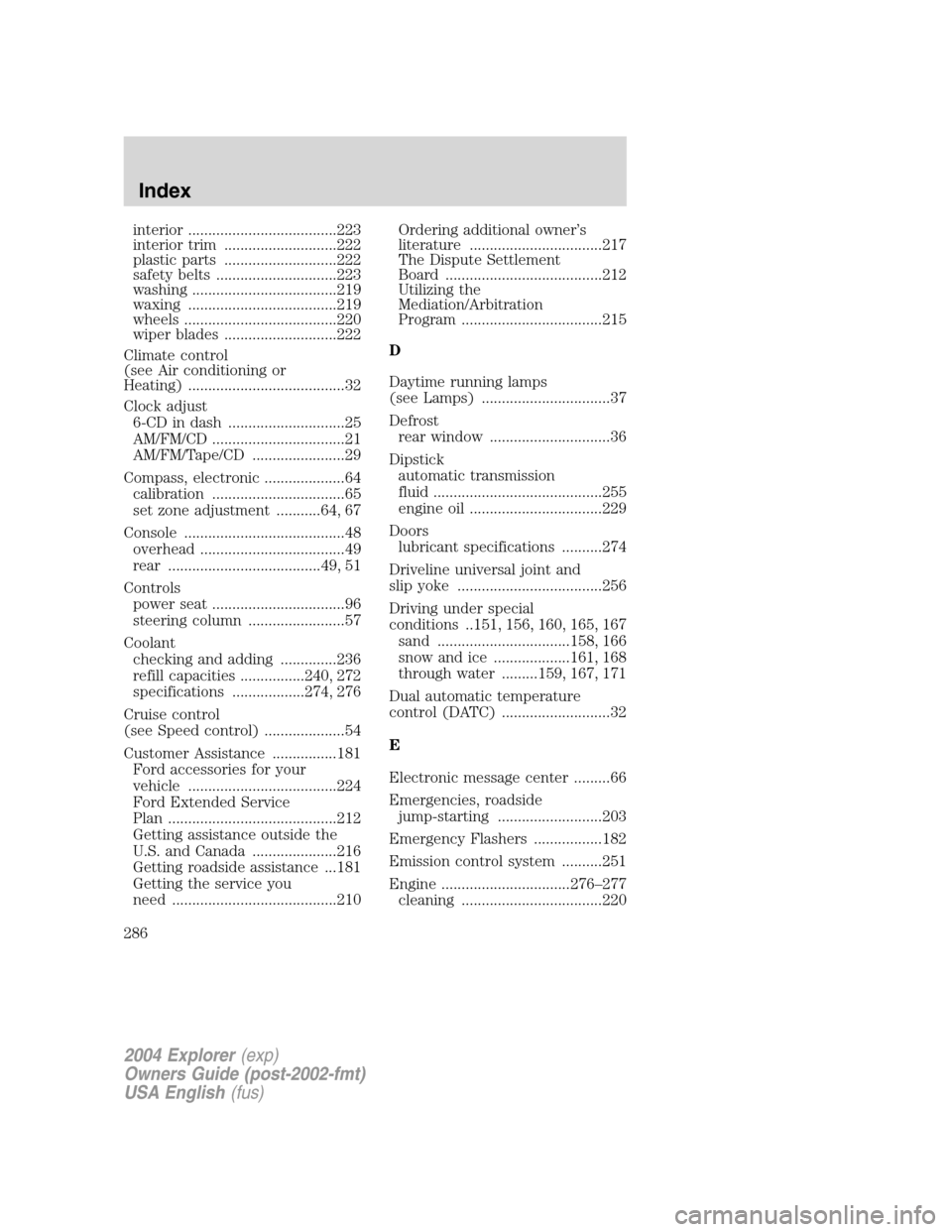
interior .....................................223
interior trim ............................222
plastic parts ............................222
safety belts ..............................223
washing ....................................219
waxing .....................................219
wheels ......................................220
wiper blades ............................222
Climate control
(see Air conditioning or
Heating) .......................................32
Clock adjust
6-CD in dash .............................25
AM/FM/CD .................................21
AM/FM/Tape/CD .......................29
Compass, electronic ....................64
calibration .................................65
set zone adjustment ...........64, 67
Console ........................................48
overhead ....................................49
rear ......................................49, 51
Controls
power seat .................................96
steering column ........................57
Coolant
checking and adding ..............236
refill capacities ................240, 272
specifications ..................274, 276
Cruise control
(see Speed control) ....................54
Customer Assistance ................181
Ford accessories for your
vehicle .....................................224
Ford Extended Service
Plan ..........................................212
Getting assistance outside the
U.S. and Canada .....................216
Getting roadside assistance ...181
Getting the service you
need .........................................210Ordering additional owner’s
literature .................................217
The Dispute Settlement
Board .......................................212
Utilizing the
Mediation/Arbitration
Program ...................................215
D
Daytime running lamps
(see Lamps) ................................37
Defrost
rear window ..............................36
Dipstick
automatic transmission
fluid ..........................................255
engine oil .................................229
Doors
lubricant specifications ..........274
Driveline universal joint and
slip yoke ....................................256
Driving under special
conditions ..151, 156, 160, 165, 167
sand .................................158, 166
snow and ice ...................161, 168
through water .........159, 167, 171
Dual automatic temperature
control (DATC) ...........................32
E
Electronic message center .........66
Emergencies, roadside
jump-starting ..........................203
Emergency Flashers .................182
Emission control system ..........251
Engine ................................276–277
cleaning ...................................220
2004 Explorer(exp)
Owners Guide (post-2002-fmt)
USA English(fus)
Index
286
Page 288 of 296
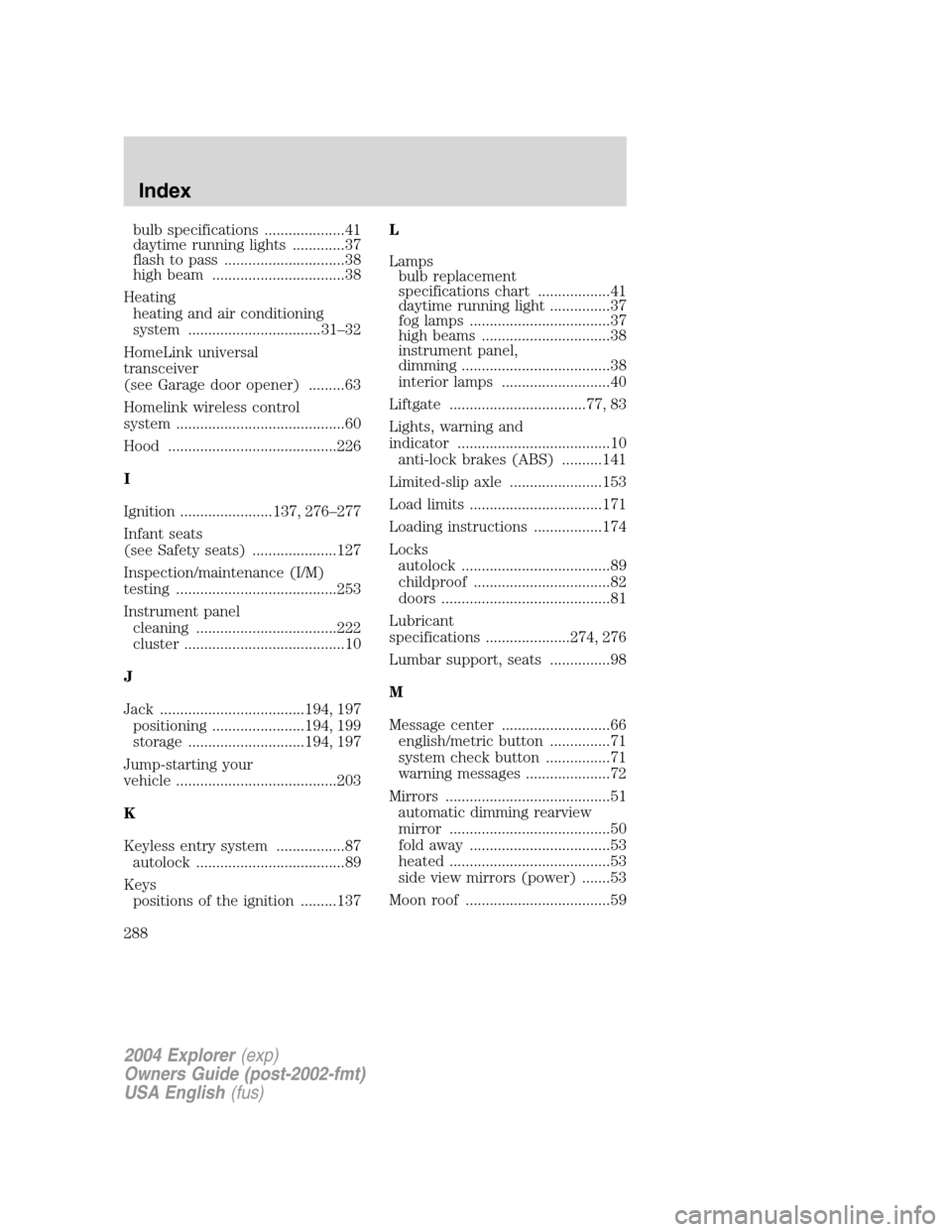
bulb specifications ....................41
daytime running lights .............37
flash to pass ..............................38
high beam .................................38
Heating
heating and air conditioning
system .................................31–32
HomeLink universal
transceiver
(see Garage door opener) .........63
Homelink wireless control
system ..........................................60
Hood ..........................................226
I
Ignition .......................137, 276–277
Infant seats
(see Safety seats) .....................127
Inspection/maintenance (I/M)
testing ........................................253
Instrument panel
cleaning ...................................222
cluster ........................................10
J
Jack ....................................194, 197
positioning .......................194, 199
storage .............................194, 197
Jump-starting your
vehicle ........................................203
K
Keyless entry system .................87
autolock .....................................89
Keys
positions of the ignition .........137L
Lamps
bulb replacement
specifications chart ..................41
daytime running light ...............37
fog lamps ...................................37
high beams ................................38
instrument panel,
dimming .....................................38
interior lamps ...........................40
Liftgate ..................................77, 83
Lights, warning and
indicator ......................................10
anti-lock brakes (ABS) ..........141
Limited-slip axle .......................153
Load limits .................................171
Loading instructions .................174
Locks
autolock .....................................89
childproof ..................................82
doors ..........................................81
Lubricant
specifications .....................274, 276
Lumbar support, seats ...............98
M
Message center ...........................66
english/metric button ...............71
system check button ................71
warning messages .....................72
Mirrors .........................................51
automatic dimming rearview
mirror ........................................50
fold away ...................................53
heated ........................................53
side view mirrors (power) .......53
Moon roof ....................................59
2004 Explorer(exp)
Owners Guide (post-2002-fmt)
USA English(fus)
Index
288